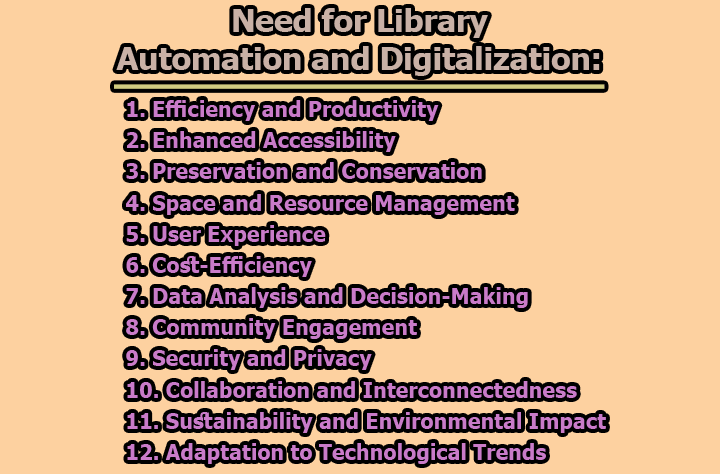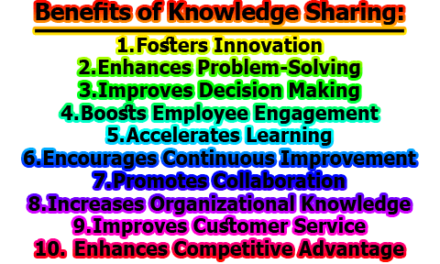Need for Library Automation and Digitalization:
Library automation and digitalization are critical processes that have transformed traditional libraries into modern information hubs. These advancements have become necessary due to the evolving information landscape and the growing demands of library users. Here, we’ll explore the need for library automation and digitalization by exploring various aspects and their implications.
1. Efficiency and Productivity:
- Streamlined Workflows: Library automation involves implementing integrated library systems (ILS) or library management software. These systems automate routine tasks like cataloging, acquisitions, and circulation. For instance, cataloging is simplified as bibliographic data can be imported from shared databases, reducing manual data entry. Acquisitions are streamlined with digital ordering and tracking systems. Circulation processes benefit from automated check-in, check-out, and hold requests.
- Reduced Human Error: Automation significantly reduces the risk of human errors. For example, automated systems can cross-reference information, ensuring that catalog records match the actual holdings accurately. This reduces discrepancies and enhances the integrity of the library’s catalog.
- Time Savings: By automating repetitive tasks, librarians can allocate more time to tasks that require their expertise, such as assisting patrons with complex research inquiries, developing educational programs, or curating specialized collections.
2. Enhanced Accessibility:
- Remote Access: Digitalization enables libraries to offer remote access to their resources. Users can access digital catalogs, databases, e-books, and e-journals from anywhere with an internet connection. This extends library services to online learners, researchers, and individuals with limited mobility.
- Accessibility Features: Digital content can be made more inclusive through features like screen readers for the visually impaired, adjustable fonts for readability, and text-to-speech functionality. These accessibility features ensure that library resources are available to a broader audience.
- 24/7 Availability: Unlike physical libraries with operating hours, digital collections are available 24/7. This accommodates diverse schedules and time zones, allowing users to access information at their convenience.
3. Preservation and Conservation:
- Digital Preservation: Digitization involves creating digital copies of physical materials. These digital copies can be stored indefinitely without degradation, ensuring the long-term preservation of valuable, fragile, or deteriorating materials.
- Risk Mitigation: Digitization reduces the physical handling of delicate and rare items, minimizing the risk of damage, theft, or loss. Specialized equipment can be used to digitize materials without exposing them to harmful environmental conditions.
- Sharing and Collaboration: Digital copies of unique materials can be easily shared with other institutions for collaborative research, exhibitions, or educational purposes. This collaborative approach enhances the preservation and dissemination of cultural and historical knowledge.
4. Space and Resource Management:
- Physical Space Optimization: Digitalization reduces the need for extensive physical storage space. Libraries can repurpose space previously used for stacks to create collaborative workspaces, host community events, or offer technology resources.
- Resource Optimization: Automation provides real-time data on the usage of materials. This data-driven approach allows libraries to optimize their collections by acquiring more of what users need, reducing redundant materials, and weeding out outdated or low-demand items.
5. User Experience:
- Efficient Searching: Online catalogs equipped with advanced search algorithms and metadata indexing enable users to find materials quickly and accurately. Users can search by various criteria, including author, subject, publication date, and keyword, enhancing the discoverability of resources.
- Multimedia Content: Digital libraries can incorporate multimedia elements such as videos, interactive simulations, virtual reality experiences, and 3D models. These multimedia resources make learning and research more engaging and comprehensive.
- Personalization: Through user profiles and data analytics, libraries can offer personalized recommendations. This helps users discover relevant materials based on their past searches and preferences, creating a tailored and engaging library experience.
6. Cost-Efficiency:
- Long-Term Savings: While there may be upfront costs associated with library automation and digitization, the long-term savings can be substantial. Reduced labor costs, decreased physical storage expenses, and minimized maintenance costs contribute to ongoing financial efficiency.
- Collaborative Funding: Libraries can collaborate regionally or globally to share the costs of digitization efforts, making it more economically viable for individual institutions. Consortia or partnerships can pool resources for large-scale digitization projects.
7. Data Analysis and Decision-Making:
- User Insights: Digital libraries generate vast amounts of data on user behavior and preferences. Librarians can analyze this data to gain insights into what resources are most popular, what topics are trending, and how patrons interact with the library’s digital offerings. This data-driven approach can inform collection development decisions.
- Resource Optimization: Beyond optimizing physical collections, data analysis can help libraries assess the effectiveness of digital resources. Libraries can determine which digital materials are most frequently accessed, allowing them to make informed decisions about renewing subscriptions or acquiring additional digital content in specific subject areas.
- Personalized Services: Data analysis can also be used to personalize services. For example, libraries can send tailored email notifications to users about newly acquired materials that match their interests, creating a more engaging and user-centric experience.
8. Community Engagement:
- Digital Storytelling: Libraries can engage with their communities by digitizing and sharing local history, cultural heritage, and personal stories. This can strengthen community identity and create a sense of belonging.
- Collaborative Projects: Libraries can collaborate with local organizations, schools, or individuals to digitize and share valuable community resources, fostering partnerships and community involvement.
- Community Input: Digital platforms can facilitate community input into library collections and services, allowing patrons to suggest acquisitions, share local knowledge, or participate in online forums and discussions.
9. Security and Privacy:
- Data Security: Libraries must prioritize data security to protect user information, especially in digital systems. This includes safeguarding personal information, circulation records, and any sensitive data related to library operations.
- Digital Preservation Security: Digital preservation efforts require robust security measures to prevent unauthorized access or tampering with digital collections. Ensuring the authenticity and integrity of digital materials is essential.
- Privacy Concerns: Libraries must balance the need for data analytics with user privacy concerns. Implementing privacy policies, anonymizing user data, and obtaining consent for data collection are vital considerations in the digital library landscape.
10. Collaboration and Interconnectedness:
- Interlibrary Cooperation: Libraries can collaborate on a regional, national, or international scale to share digital resources, reducing duplication of efforts and broadening access to materials. Consortia can negotiate collective purchasing agreements and share digital repositories.
- Global Accessibility: Libraries can contribute to global knowledge sharing by making their digital collections openly accessible. Open access initiatives can lead to the creation of vast, interconnected digital repositories that benefit researchers and learners worldwide.
- Cross-Disciplinary Research: Digitalization allows libraries to support cross-disciplinary research by making resources from diverse fields easily accessible. This interdisciplinary approach encourages innovation and problem-solving.
11. Sustainability and Environmental Impact:
- Reduced Physical Resources: Library automation and digitalization significantly reduce the need for physical resources like paper, ink, and storage materials. This has a positive impact on sustainability by reducing resource consumption and waste generation.
- Energy Efficiency: Digital libraries, while requiring energy for servers and data centers, often have a smaller carbon footprint compared to traditional libraries with extensive heating, cooling, and lighting requirements.
- Remote Access and Reduced Commuting: Digital libraries contribute to reduced commuting as users can access resources remotely. This has implications for reducing traffic congestion, emissions, and the environmental impact of transportation.
12. Adaptation to Technological Trends:
- Digital Literacy Initiatives: Libraries play a crucial role in promoting digital literacy. As technology evolves, librarians can offer workshops, training sessions, and resources to help users navigate the digital landscape effectively. This includes teaching skills like evaluating online sources, using research databases, and understanding data privacy.
- Integration with Emerging Technologies: Libraries can stay at the forefront of technological trends by integrating emerging technologies into their services. For example, they can offer virtual reality experiences, 3D printing services, or augmented reality tools to enhance learning and research opportunities.
- Digital Preservation Challenges: As technology evolves, libraries face ongoing challenges in preserving digital content. They must keep up with changing file formats, storage technologies, and digital rights management to ensure the long-term accessibility of digital resources.
It is apparent that library automation and digitalization are essential to meet the evolving needs of patrons, enhance operational efficiency, and ensure the preservation and accessibility of valuable resources. By leveraging technology, libraries can continue to serve as vital hubs of knowledge and community engagement in the digital age.

Assistant Teacher at Zinzira Pir Mohammad Pilot School and College










